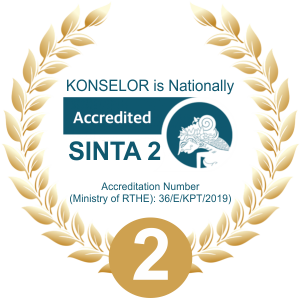Student Team Achievement Division (STAD) as an alternative method of counseling guidance in improving student social interaction
 ),
), (1) universitas kanjuruhan malang
 Corresponding Author
Corresponding Author
Copyright (c) 2019 khairul bariyyah
DOI : https://doi.org/10.24036/0201982104138-0-00
Full Text:
 Language : id
Language : id
Abstract
Keywords
References
Arjanggi, R., & Setiowati, E. A. (2014). The effectiveness of student team-achievement division to increase self-regulated learning. In Proceedings of the 8th International Technology, Education and Development Conference (INTED) (pp. 2379–2383).
Bada, S. O., & Olusegun, S. (2015). Constructivism learning theory: A paradigm for teaching and learning. Journal of Research & Method in Education, 5(6), 66–70.
Creswell, J. W., & Creswell, J. D. (2017). Research Design: Qualitative, Quantitative, and Mixed Methods Approaches. Thousand Oaks, CA: Sage Publications.
Fatnar, V. N., & Anam, C. (2014). Kemampuan interaksi sosial antara remaja yang tinggal di pondok pesantren dengan yang tinggal bersama keluarga. Empathy, 2(2), 71–75.
Gull, F., & Shehzad, S. (2015). Effects of Cooperative Learning on Students’ Academic Achievement. Journal of Education and Learning, 9(3), 246–255.
Harfiyanto, D., Utomo, C. B., & Budi, T. (2015). Pola Interaksi Sosial Siswa Pengguna Gadget di SMA N 1 Semarang. Journal of Educational Social Studies, 4(1).
Hariyanto, M., Mukhadis, A., & Isnandar, I. (2012). Pembelajaran Kooperatif Tipe STAD Untuk Meningkatkan Interaksi Dalam Proses dan Hasil Belajar Mengefrais Roda Gigi Lurus Pada Siswa SMK. Teknologi Dan Kejuruan: Jurnal Teknologi, Kejuruan Dan Pengajarannya, 35(1).
Khairiyanti, Y. (2010). Penerapan cooperative learning model think pair share untuk meningkatkan aktivitas belajar siswa dalam pelayanan BK di kelas VII D di SMPN 1 Asembagus. Penerapan Cooperative Learning Model Think Pair Share Untuk Meningkatkan Aktivitas Belajar Siswa Dalam Pelayanan BK Di Kelas VII D Di SMPN 1 Asembagus/Yuni Khairiyanti.
Kusumawati, H., & Mawardi, M. (2016). Perbedaan Penerapan Model Pembelajaran Kooperatif Tipe NHT dan STAD Ditinjau dari Hasil Belajar Siswa. Scholaria: Jurnal Pendidikan Dan Kebudayaan, 6(3), 251–263.
Muflih, M., Hamzah, H., & Purniawan, W. A. (2017). Penggunaan Smartphone Dan Interaksi Sosial Pada Remaja di SMA Negeri I Kalasan Sleman Yogyakarta. Idea Nursing Journal, 8(1), 12–18.
Mulyaningsih, I. E. (2014). Pengaruh interaksi sosial keluarga, motivasi belajar, dan kemandirian belajar terhadap prestasi belajar. Jurnal Pendidikan Dan Kebudayaan, 20(4), 441–451.
Rahma, W. (2017). Pengaruh Penggunaan Metode Kooperatif Window Shopping Terhadap Partisipasi Bimbingan Konseling Klasikal. Jurnal Penelitian Pendidikan Indonesia, 2(2).
Ramdhani, M. A. (2017). Lingkungan Pendidikan dalam Implementasi Pendidikan Karakter. Jurnal Pendidikan UNIGA, 8(1), 28–37.
Rey, D., & Neuhäuser, M. (2011). Wilcoxon-signed-rank test. In International encyclopedia of statistical science (pp. 1658–1659). Springer.
Salavera, C., Usán, P., & Jarie, L. (2017). Emotional intelligence and social skills on self-efficacy in Secondary Education students. Are there gender differences? Journal of Adolescence, 60, 39–46.
Santoso, H. (2016). Pembelajaran Di Sekolah Sebagai Wahana Pengembangan Karakter Perserta Didik. Jurnal Lentera Pendidikan Pusat Penelitian LPPM UM Metro, 1(2), 197–203.
Suprihatin, S. (2017). Kompetensi Profesional Guru Bimbingan dan Konseling Dalam Pelayanan Bimbingan dan Konseling. JIGC, 1(1), 14–26.
Suprijono, A. (2014). Cooperative learning: teori & aplikasi PAIKEM. Yogyakarta: Pustaka Pelajar.
Wati, D. P., Yamtinah, S., & Masykuri, M. (2018). Penerapan Model Pembelajaran Student Teams Achievement Division (STAD) Dilengkapi LKS untuk Meningkatkan Interaksi Sosial dan Prestasi Belajar Siswa pada Materi Termokimia Kelas XI IPA SMA Islam 1 Surakarta Tahun Pelajaran 2016/2017. Jurnal Pendidikan Kimia, 7(1), 55–61.
Yuliarni, E., Luawo, M. I. R., & Karsih, K. (2013). Pengaruh Penerapan Model Cooperative Learning Tipe Stad (Student Teams Achievement Division) Dalam Layanan Bimbingan Klasikal Terhadap Keterampilan Belajar Siswa Dalam Membaca Dengan Teknik SQ3R (Studi Pre-Eksperimen Pada Siswa Kelas X-F Di SMAN 8 Bogor). Insight: Jurnal Bimbingan Konseling, 2(1), 25–31.
Yusuf, Y. Q., Natsir, Y., & Hanum, L. (2015). A Teacher’s Experience in Teaching with Student Teams-Achievement Division (STAD) Technique. International Journal of Instruction, 8(2), 99–112.
 Article Metrics
Article Metrics
 Abstract Views : 1469 times
Abstract Views : 1469 times
 PDF Downloaded : 260 times
PDF Downloaded : 260 times
Refbacks
- There are currently no refbacks.
Copyright (c) 2019 khairul bariyyah

This work is licensed under a Creative Commons Attribution 4.0 International License.







